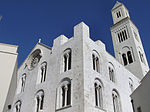Castello Normanno-Svevo (Bari)
1132 establishments in Europe12th-century establishments in ItalyBuildings and structures completed in 1132Buildings and structures in BariCastles in Apulia

The Castello Svevo or Swabian Castle (Italian: Castello normanno-svevo), also known as the Houhenstaufen Castle, is a castle in the Apulian city of Bari, Italy. Built around 1132 by Norman King Roger II, it is currently used for exhibitions.
Excerpt from the Wikipedia article Castello Normanno-Svevo (Bari) (License: CC BY-SA 3.0, Authors, Images).Castello Normanno-Svevo (Bari)
Corso Senatore Antonio De Tullio, Bari San Nicola
Geographical coordinates (GPS) Address Nearby Places Show on map
Geographical coordinates (GPS)
| Latitude | Longitude |
|---|---|
| N 41.128558333333 ° | E 16.866388888889 ° |
Address
Museo del Castello
Corso Senatore Antonio De Tullio
70122 Bari, San Nicola
Apulia, Italy
Open on Google Maps









